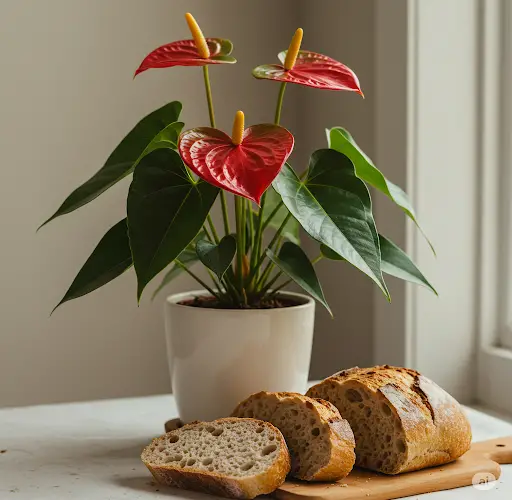Anthuriums are among the most loved indoor plants for their glossy leaves and long-lasting, vibrant blooms. But many plant owners find themselves wondering why their Anthuriums stop flowering after a while, even with regular watering and good light. While commercial fertilizers can help, there’s a surprisingly simple kitchen item that can encourage steady, beautiful blooms: a slice of bread.
It may sound odd, but bread can be an effective natural fertilizer when used correctly. A slice of bread offers nutrients and organic matter that benefit the soil, improve microbial life, and give your Anthurium the conditions it needs to flower continuously. Let’s explore how this humble household staple works and how to apply it to your plant care routine.
Why Bread Works for Anthuriums
At first glance, bread doesn’t seem like a typical fertilizer. But when broken down, it provides multiple benefits to flowering plants like Anthuriums:
-
Rich in Carbohydrates
Bread contains complex carbohydrates that, when decomposed, serve as a food source for beneficial microorganisms in the soil. These microbes enhance nutrient availability and root health—two key factors for blooming. -
Contains Small Amounts of Yeast and Proteins
Most bread contains trace amounts of yeast and proteins that can stimulate microbial activity. A more active soil ecosystem can better support flowering and overall plant growth. -
Acts as Organic Matter
As bread breaks down, it contributes to the organic content of the soil. This improves soil texture and water retention—especially helpful in indoor containers where soil tends to compact over time. -
Gentle Nutrient Release
Bread releases nutrients slowly as it decomposes, making it a low-risk addition for delicate houseplants. Unlike synthetic fertilizers, it won’t burn roots when applied in moderation.
How to Use Bread to Encourage Anthurium Blooms
Here’s a step-by-step guide to safely use bread as a natural boost for your Anthurium:
1. Choose Plain Bread
Use fresh or slightly stale plain white or whole wheat bread—not seasoned or moldy types. Avoid breads with garlic, onion, salt, sugar, or preservatives, which could harm the plant or attract pests.
2. Break into Small Pieces
Tear the bread slice into small chunks or crumble it into bits. Smaller pieces decompose faster and integrate better into the soil.
3. Apply to the Soil
Sprinkle the bread pieces on the surface of the soil or bury them lightly into the top layer (about 1–2 cm deep). Burying helps prevent mold and keeps insects like fruit flies away.
4. Use One Slice per Month
Limit the use to one slice per month per medium-sized pot. Overdoing it can lead to unpleasant odors or fungal growth if the bread doesn’t decompose properly.
5. Water as Usual
After applying the bread, water your Anthurium normally. The moisture will help the bread break down and activate the soil microbes.
Best Practices for Success
Using bread alone won’t solve every blooming issue. For consistent flowering, combine this trick with a proper care routine:
-
Light: Anthuriums love bright, indirect sunlight. A spot near an east-facing window is ideal. Avoid direct midday sun, which can burn the leaves.
-
Watering: Let the top inch of soil dry before watering. Too much water leads to root rot, while too little can stress the plant and reduce flowering.
-
Humidity: These tropical plants need humidity to thrive. Mist regularly or use a tray of water and pebbles to increase moisture in the air.
-
Cleaning: Dusty leaves block light. Gently wipe them with a damp cloth every couple of weeks to keep them clean and healthy.
-
Fertilization: While the bread slice provides some nutrients, a diluted liquid fertilizer for flowering plants can be used every 6–8 weeks to supplement growth.
What to Expect After Using Bread
With regular use—around once a month—alongside proper care, you may begin to see improvements in both foliage quality and blooming cycles. The leaves may look more lush and vibrant, and the plant may start producing more buds and flowers.
It’s important to be patient. This method relies on natural decomposition, so the benefits come gradually over time. However, it’s a safe, gentle, and budget-friendly way to support your Anthurium without resorting to synthetic fertilizers.
Conclusion: Simple and Effective Plant Care from Your Kitchen
The next time you notice your Anthurium slowing down on blooms, consider this easy and eco-friendly solution hiding in your breadbox. A simple slice of plain bread can help stimulate natural soil processes, enhance root health, and provide the right conditions for your plant to bloom more often.
With just a bit of attention and a slice of bread once a month, you can enjoy a healthier, more vibrant Anthurium—all without expensive treatments or harsh chemicals.



